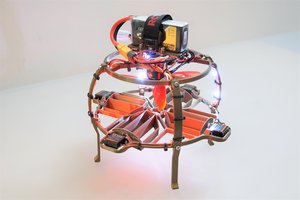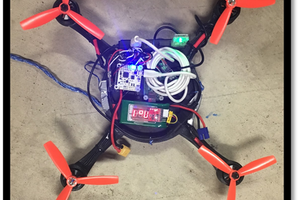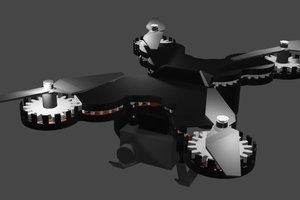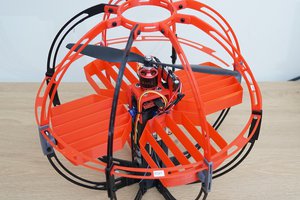Overview: This craft is based on existing design by Flite Test for a flying wing style aircraft. It composed entirely of paper-line foam project boards (like the ones your grade school presentations would be glued to). These are available at the dollar store, making this airframe a total of $2 in raw material.
Additional materials include bamboo BBQ skewers, zip ties, velcro, hot glue, and a 3D printed firewall. The paper is sealed with plain old minwax polyurethane for dew proofing.
This craft incorporates a tradition fixed wing, lifting body design, combined with a tri-copter multi-rotor layout.
Mechanical: The heart of this project mechanically is the tilt rotor mechanism to which the two front rotor are mounted. The front rotors tilt a full 90° to transition between hover mode and forward flight. When in hover, the rotors tilt roughly 5° in opposite directions to provide yaw control. The rear rotor is fixed.
When in forward flight, the rear rotors is turned off, and the front rotors use differential thrust for yaw control. Roll and pitch are controlled by tradition control surfaces (elevons) in this case.
The front boom is composed of 7 bamboo skewers arranged in a patters simiar to 7 strand wire. No adhesive is used to bond the skewers themselves, but they are held together with 1/2" shrink tube. Torsional ridgidity is acceptable, but future designs would incorporate some adhesive within the skewer bundle, or skip the skewers for a carbon tube.
Glued to the end of each boom is custom aluminum "bearing" on which the motor mount rides. The motor mount itself is 3D printed, and its gear is integrated in to the one piece mount. The servo gear is likewise 3D printed, and is heat pressed onto the splined shaft of the servo. The gear ratio here is 1:1. The servo provides JUST enough travel to get the job done. Original designs considered a gearing ratio that would give more than 120° of rotation, but I worried about transmission of torque through the gears and to the servo in a hard landing. Luckily 1:1 worked out.
The gears were printed with a 0.2mm nozzle, the smallest I have ever used. They were also printed extremely slowly to ensure an accurate tooth profile. My previous attempts at gear printing (an orrery) did not result in a robust gear train, mostly due to mishapen teeth due to inertial effects. The material is PLA, and the printer used was a cheap prusa i3 clone.
PowerTrain: The powertrain consists of off-the-shelf hobby motors, speed controllers, props, and LiPo batteries.
Radio: Also off the shelf mostly, mix of Turnigy and FrSky equipment.
Flight Controller: There is a TON of magic here that I am not responsible for. This project sprang forth in my mind due to my discovery of a nearly 10 year old project going on at RCGroups.com. Two incredible members (handles: HappySundays and Ran. D. St. Clair) have developed a custom firmware for an otherwise basic Flight Controller called the KK2. Their firmware handles all of the mixing and programming needed to control hover, forward flight, and the transition between the two. I encourage anyone interested to check it out, links are included in this post. I do not know these individuals and have only limited participation in the forum thread, but the job they did on this project is remarkable!
Odds and ends: A quirk in the FrSky radio equipment results in the requirement of a signal inverter for the radio receiver to talk to the flight controller via serial interface, which is preferred. These cables had been more available in years past, but I was not able to easily located one which I could obtain quickly. I did order one on the slow boat from Chine, but in the mean time I had almost everything I needed to make one lying around. 4 resistors, a PNP transistor, and a proto-board milled to size did the...
Read more »
 Benjamin Prescher
Benjamin Prescher
 sujoy2900
sujoy2900
 Future1xtech
Future1xtech